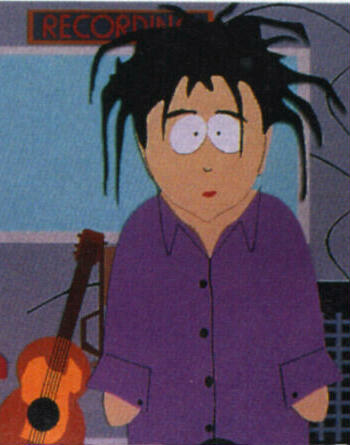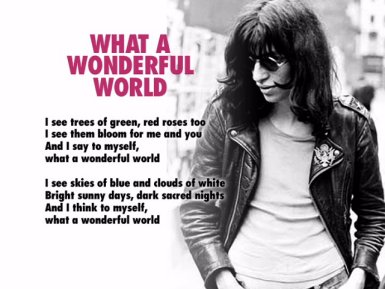 The Cure
The Cure began life as The Easy Cure, forming in 1976 when 17 year old Robert Smith joined with schoolmates Michael Dempsey and Lol Tolhurst and local guitar hero
Porl Thompson and immediately began writing and demoing their own songs, including early classics such as "Killing an Arab" and "10:15 Saturday Night".
In April 1977 the group of recent school leavers saw a competition advertised in Melody Maker for Hansa Records, Germany's largest independent label, who were seeking new bands. "Wanna Be A Recording Star?" it said. The Easy Cure did, and won. This should have led to the release of a debut single and album, but for the doomed nature of the relationship — Hansa saw The Easy Cure as a ‘fresh faced’ and malleable pop group — but even at this relatively young age, a headstrong Robert Smith had other ideas… Within one unsatisfactory year they had parted company with nothing having been released. At this stage the band lost the tag “Easy” and their guitar hero Porl.
The Cure continued to record and send out demos, looking for another record label to sign to. They'd been rejected by everyone until Chris Parry, an A&R man at Polydor who'd signed and produced
The Jam and who'd been instrumental in signing
Siouxsie And The Banshees, heard their demo. The Cure signed with Parry’s new
Fiction label in September 1978, which was to prove a lasting partnership. Work began immediately on their first single “Killing An Arab”, based on
Albert Camus’ existentialist novel
“The Stranger”, which was released in December 1978. 15000 copies were released on “Small Wonder” records, an independent label chosen when it was evident that Polydor, through whom Fiction were licensed, were too inflexible to market any Cure product before Christmas. The single was re-released on Fiction in January 1979.
The music papers unanimously made "Killing An Arab" single of the week, praising its "Moorish flavoured guitar pattern" and salivating over Smith's fashionably bleak outlook - "I'm alive, I'm dead...". The debut album, a mix of quirky pop and melodic post-punk tunes, quickly followed on Fiction which kick-started an extensive UK touring period, during which The Cure played with various other emergent bands of the time such as
Wire,
Joy Division and The Jam. This period also saw the development of a long standing affiliation between The Cure and Siouxsie and The Banshees, as within two dates of their support slot on the Banshee’s UK tour in late 1979, Robert found himself playing two sets a night, one for The Cure and one for The Banshees, having stepped into the breach for departed guitarist John McKay. This led to disharmony amongst the other Cure members and Dempsey left to join Fiction labelmates
The Associates, to be replaced immediately by Simon Gallup.
Matthieu Hartley also joined soon after and in early 1980 the 4-piece Cure embarked on two weeks of studio experimentation, exploring the darker side of Smith’s songwriting, and emerged with the minimalist classic Seventeen Seconds, including 'A Forest' which became the band’s first bona fide UK hit single. With Seventeen Seconds climbing to #20 in the UK album charts, The Cure set out on an extensive and drug induced tour of Europe, the USA and Australasia.
The band’s sound would continue to grow grimmer, darker and increasingly morbid with 1981’s Faith which reached #14 in the UK album charts and even more so with 1982’s Pornography which entered the UK Top 10 at #9.
Making albums of such nerve-shredding intensity, however, was taking its toll not just on Smith but on everyone around him. He was living the excessive life his music seemed to demand, pumping numerous chemical stimulants into his body. The band's keyboardist, Matthieu Hartley, had jumped ship after a furniture-wrecking fight in a hotel during the Australasian tour of 1981 and now Simon Gallup found it impossible to remain in the band. Smith at this stage had threatened to quit music altogether, and so against all expectations, the next Cure single was the cheesy disco of "Let’s Go To Bed", an instant if unexpected pop hit in America.
Their next recordings would continue to bounce between the old and new directions, a blend of pop perfection and gothic reveries, including 1987’s eclectic double album “Kiss Me, Kiss Me, Kiss Me”, from which this post derives.
Robert Smith has continued to tour and record with the ever changing cast of Cure band members and to perform his Goth-infused pop and in 2004 the band released their eponymous album “The Cure”, Smith's 13th studio album. The early Cure albums have recently been remastered and released with additional tracks.
Dinosaur Jr. were largely responsible for returning lead guitar to indie rock and, along with their peers such as
Sonic Youth and
The Pixies, they injected the late 1980s alternative rock scene with monumental levels of guitar noise. Frontman
J Mascis and bassist
Lou Barlow formed the band, originally called Dinosaur, in 1985 and were soon joined by drummer Murph. They created an extremely dysfunctional and internally aggressive band, but also the most highly regarded line-up.
After the first three albums Mascis and Murph sacked Barlow in 1989, who would continue his own musical pursuits in
Sebadoh and the
Folk Implosion as well as a solo career. Murph left several years later and Mascis continued to record and perform under the moniker of Dinosaur Jr, as well as J Mascis and The Fog.
Good news for Dinosaur Jr fans, and for anyone who wants to see a long-absent band that casts a stegosaurus-sized shadow over indie-rock, the original lineup of Dinosaur Jr. has reunited for a full slate of U.S. shows including the
Lollapalooza Festival and some overseas dates. Their first 3 albums have also recently been remastered.
The Cure - Just Like HeavenDinosaur Jr - Just Like Heaven










